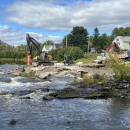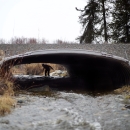States
IndianaThis project will remove the Shadyside Park Dam on Killbuck Creek, a major tributary of the Upper White River in Indiana. This low-head dam blocks fish migration, degrades quality aquatic habitat, and is a hazard to recreational users of Killbuck Creek. Successful removal of the Shadyside Park Dam will restore fish passage fish passage
Fish passage is the ability of fish or other aquatic species to move freely throughout their life to find food, reproduce, and complete their natural migration cycles. Millions of barriers to fish passage across the country are fragmenting habitat and leading to species declines. The U.S. Fish and Wildlife Service's National Fish Passage Program is working to reconnect watersheds to benefit both wildlife and people.
Learn more about fish passage to over 52 miles of the White River and Killbuck Creek. The reconnection of this previously fragmented major tributary will benefit several mussel species including federally endangered snuffbox, northern riffleshell, slippershell, wavyrayed lampmussel, spike, sheepnose, rabbitsfoot, rainbow, clubshell, kidneyshell, purple lilliput, rayed bean, and little spectaclese. Removal of this dam will allow the river system to return to a natural condition that is more resilient to changes in climate. In addition to benefits to the native wildlife, the removal will benefit local anglers and improve recreational access along the White River.
Project Quick Facts:
| Project Status | In Development |
| Location | IN, Madison County |
| NFPP Project Funding | $300,000 |
| Restoration Techniques | Dam Removal |
| Accomplishments | 53 Stream Miles Reopened |
| Partner Project Lead | Flatland Resources |
The National Fish Passage Program combines technical expertise with a track record of success.
Implemented primarily through the Service's Fish and Wildlife Conservation Offices, the National Fish Passage Program provides financial and technical assistance to partners across the country. Since 1999, the program has worked with over 2,000 local communities, Tribes, and private landowners to remove or bypass over 3,400 barriers to fish passage and reopen access to over 61,000 miles of upstream habitat for fish and other animals. Staff have expertise in fish migration and biology as well as financial, engineering, and planning assistance to communities, Tribes, and landowners to help them remove barriers and restore rivers for the benefit both fish and people.
Fish passage project proposals can be initiated by any individual, organization, government, or agency. However, proposals must be submitted and completed in cooperation with a Fish and Wildlife Conservation Office. (Please note that fish passage projects being used for federal or state compensatory mitigation or required by existing federal or state regulatory programs are not eligible for funding through the National Fish Passage Program.)
CONTACT A FISH PASSAGE COORDINATOR IN YOUR AREA TO GET STARTED.


